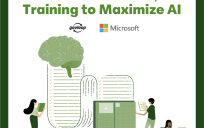High costs remain a critical barrier for government agencies seeking to advance their AI capabilities. For example, a recent report from Epoch AI found that the costs to build and train AI models doubles every nine months.
Financial pressures like this underscore the need for creative solutions for agencies to maximize returns on their AI investment. Fortunately, cost-effective strategies for workforce upskilling, utilizing shared AI resources and implementing more efficient tools are available to help agencies significantly cut development costs while maintaining robust security and high-quality standards around their AI investments.
The Cost Challenges Facing AI Innovation
Deploying AI comes with inherent affordability challenges that are driven by mitigating workforce factors. Challenges in workforce adoption further impact the affordability picture because, to be cost effective, AI must be usable across the organization for a broad range of agency stakeholders.
Unfortunately, this is easier said than done. Research by the World Economic Forum shows that roughly 40% of the workforce will need to reskill and upskill before AI can be effectively leveraged.
Throughout, government agencies also deal with the added burden of tight regulations and staffing limits that make it difficult to field large teams capable of managing AI initiatives. These dynamics underscore the need for strategic planning to address both the technological and workforce affordability factors when it comes to implementing AI in government.
Priorities for Managing AI Costs
While the current cost challenges around AI are considerable, they are not entirely unavoidable. As enterprises learn to better strategize their implementations, they are finding strategic ways to increase the return on investment for every dollar spent on AI.
Two strategic priorities in particular are highly impactful when it comes to minimizing costs of AI:
- Optimizing Workforce Investments — Cost-effective AI requires a strategic approach to how it is used both in the general employee population and among the experts tasked with managing the organization’s AI platform. For the general workforce, targeted training programs can help employees be more agile and self-sufficient in using AI for tasks such as content creation, document summarization and document evaluation. Meanwhile, upskilling efforts for AI managers should focus on advanced areas such as data management, machine learning and AI ethics.
- Streamlining Workforce Efforts With AI-Driven Tools — AI tools can handle repetitive, time-intensive tasks, significantly reducing the burden on employees and allowing them to concentrate on higher-value strategic initiatives. Agencies can leverage pre-developed large language models (LLM), algorithms and AI tools to avoid redundant spending and maximize budget efficiency. In this way, the AI investment helps pay for itself in a shift that not only enhances productivity but also reduces operational costs tied to manual processes.
Cloud Modernization to Support Cost-Effective AI
Taken together, the two strategic priorities above can help cut costs of AI development while empowering the government workforce to meet the demands of this rapidly evolving field.
Several underlying modernization efforts can facilitate these priorities:
Precision search and advanced prompt engineering can further reduce costs by reaping more relevant AI outputs from smaller data sets. Techniques such as retrieval-augmented generation (RAG) enable agencies to optimize their resource use by adding domain-specific content to existing LLMs to further improve response clarity and accuracy. RAG enables organizations to use smaller, more efficient models without having to sacrifice response accuracy.
The growing use of compression techniques that reduce the size of LLMs while retaining roughly the same level of performance is helping lower storage and processing costs. LLMs typically run in the cloud due to their size, and these cloud hosting costs can quickly add up.
Compression technologies such as pruning (removing redundant parameters), quantization (lower precision representations) and distillation (training smaller models to mimic larger ones) can make LLMs a lot smaller, enabling them to be run on local machines at a greatly reduced cost. Running LLMs (or SLMs) locally also has the benefit of increased security when handling confidential information in the cloud.
While advancing AI capabilities remains a priority for government agencies, high costs continue to pose significant challenges. However, by embracing cost-effective strategies such as workforce upskilling, leveraging shared AI resources and implementing efficient tools, agencies can dramatically reduce development expenses.
These approaches not only ensure robust security and maintain high-quality standards but also pave the way for sustainable and scalable AI adoption in the public sector.
Burnie Legette is the Director of IOT Sales – Artificial Intelligence at Intel





Leave a Reply
You must be logged in to post a comment.